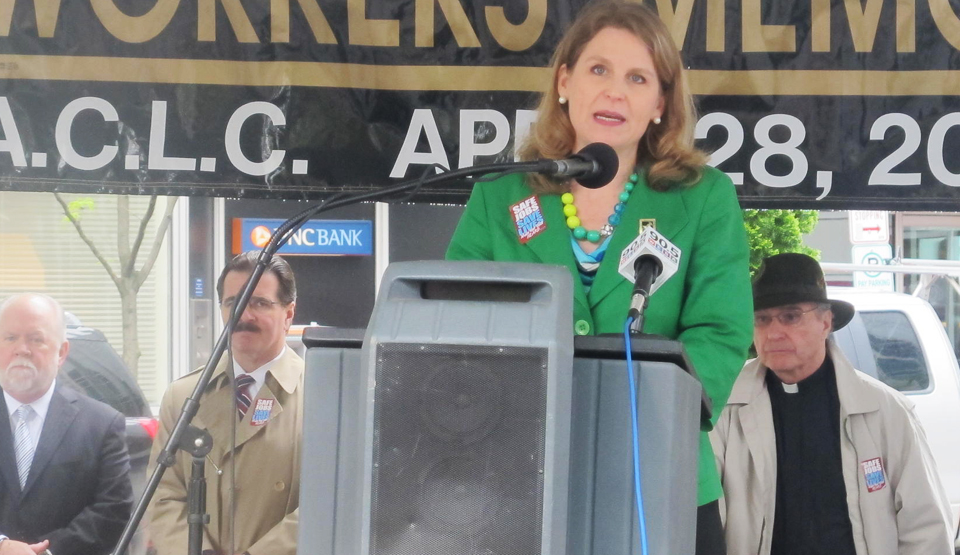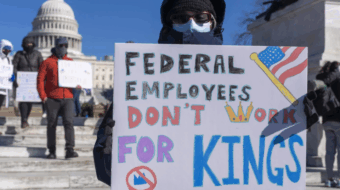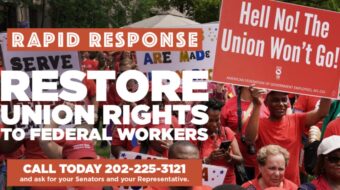
WASHINGTON—The AFL-CIO will use the high ratios of CEO pay to worker pay as part of its economic message in the 2018 political campaign, federation Secretary-Treasurer Liz Shuler says.
And some of those ratios, especially in retail trade, are completely out of sight, the federation’s 20th annual Executive Paywatch report, released May 22, shows.
“This will be part of our economic narrative in 2018,” Shuler said in unveiling the report. “When executive pay is out of control and wages for workers aren’t going up, that makes for an angry and energized populace. We plan to use this narrative going into the election.”
Overall, the median CEO pay for a Fortune 500 exec was 361 times the median worker’s pay. It means the median CEO’s compensation in a day equals the median worker’s pay for a year.
This year, for the first time, the federation was able to use the pay ratios between CEO compensation and median worker compensation mandated by the Dodd-Frank financial reregulation law. That law ordered publicly traded firms to disclose total compensation – including pay, pensions, stock options and perks – of their CEOs and other top honchos.
The law and the federal Securities and Exchange Commission also ordered the firms to disclose the median pay figure for all their workers, including full-timers, part-timers and temps in the U.S. and around the world, and calculate the ratio between the two. The median is the pay point where half the workers are above and half below.
And the retail trade industry has so many low-paid overseas workers, such as those making clothes in Bangladesh or cheap cellphones in China, that the CEO-to-median worker pay ratios in that field are astronomical.
Overall, the CEO-to-median worker pay and compensation ratio in retail trade was 791-1 in 2017, the report disclosed. That means the average CEO in the field made as much in less than half a working day as the worker in that field made in a year.
But then there’s Fran Horowitz, CEO of Abercrombie & Fitch, the high-class clothier. Her pay last year was $1.197 million, but incentive plans and stock awards pushed her total compensation to $10.262 million, less than the median CEO pay — $13.94 million — or all Fortune 500 execs in the report. Median CEO pay rose 6 percent over 2016’s figure.
The catch is A&F – also notorious for losing a Supreme Court case after discriminating against a Muslim female retail job applicant in Oklahoma — has almost all of its clothes made in low-paying nations overseas. The median pay for an A&F worker was $2,991, dead last among all the publicly traded firms in the report. The ratio between Horowitz and her median worker was 3,431-1.
And that was only the third-worst ratio, behind Weight Watchers ($33.37 million for CEO Mindy Grossman and 5,908-1 ratio) and Mattel Toy Co. Its CEO, Margaret Georgiadis, made $31.28 million, 4,987 times the median pay for a Mattel worker.
“Companies with high CEO-to-worker pay ratios may suffer from a winner-take-all philosophy where the CEOs reap the lion’s share of compensation. Employee productivity, teamwork and collaboration suffer when workers see their CEO’s pay is going up at the same time that they are asked to do more with less,” Shuler said.
“CEO pay suffers from the mythology of the superhero CEO,” added Brandon Reese, the fed’s investment director. Oher factors in rising CEO pay ad compensation include interlocking board members and keep-up-with-the-Joneses efforts by corporate boards.
They also include firms hiring new CEOs and giving them huge pay and perks to entice them away from their prior firms. Mondelez International, owner of Nabisco and maker of Oreo cookies, gave its retired CEO $17 million in pay and perks, Reese said, but lavished her successor, Dirk Van de Put with $42 million in pay and perks on an annual basis.
The median worker pay at Mondelez was $42,893 last year. The report did not make clear whether that includes the pay of the 600 veteran Oreo cookie production line workers, all Bakery, Confectionery, Tobacco and Grain Miller members, fired and laid off when the firm closed its profitable South Side Chicago Oreo line in favor of producing the cookies in Monterey, Mexico, where workers earn just over a dollar an hour – and are subject to a company union.
Hunter Harrison, CEO of CSX – one of the nation’s four mega-railroads – was the highest-compensated honcho, at $151.8 million, last year. Most of it was in stock option awards ($115.88 million) but he also saw his pension plan and deferred compensation rise by almost $30 million.
The median CSX worker earned $98,697, but that figure includes managers, other execs and professionals, as well as its unionized workers. As a result, the CSX CEO-worker pay ratio was 27-1.
Two other CEOs had total compensation in 2017 over $100 million each, Hock Tan of Broadcom Ltd. ($103.2 million) and Frank Basignano of First Data Corp. ($102 million).
The fed issued its report the day the GOP-run House was scheduled to approve a final version of a top Republican cause: Weakening Dodd-Frank. It was unclear whether the weakening legislation, S2155, would kill the executive pay revelations, though big business, which strongly pushed the emasculation, has been lobbying for covering up pay, too.
“This is a key test for President Trump to see whether he’s on our side or the side of the bankers and corporate heads,” Shuler said. “It’s very basic. We’re challenging him to veto the bill.”
He won’t. His top advisors, at the Office of Management and Budget, recommended he sign it.










